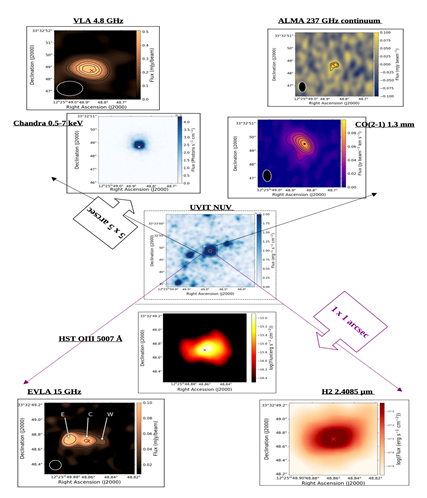Evidence of interaction between a radio jet emitted from special kind of galaxies called Active Galactic Nuclei (AGN) and the surrounding interstellar medium at small spatial scale of about 10 parsecs has been detected for the first time in a dwarf galaxy situated at a distance of about 14 million light years.
This finding challenges the hypothesis that only large and massive galaxies jets from which regulate star formation, host AGN powered by massive black holes.
AGN emit vast amounts of energy derived from matter falling into their central black holes, and can alter the properties of the interstellar medium (ISM) in the surrounding regions through feedback processes. In some cases, AGN generate focused outflows of non-thermal plasma, called radio jets, which can either heat or expel gas from their host galaxies, thereby halting star formation (a process called negative feedback). Conversely, these processes can also boost star formation by compressing gas clouds (a process termed positive feedback). While outflows have been observed in AGN hosted by galaxies similar to, or even much larger than ours, on various scales, their effectiveness and interaction with the ISM are still under debate.
While AGN are generally believed to be hosted predominantly by massive elliptical galaxies, observations over the past decade have been exploring the presence of intermediate mass central black holes in dwarf galaxies with stellar mass less than 10^9 solar mass that produce stellar feedback.
Recent observations do reveal the presence of AGN in dwarf galaxies, and these AGN could play an important role in dwarf galaxy evolution via feedback processes.
Recently, outflows too have been detected in dwarf galaxies hosting AGN, challenging previous models relying only on supernova feedback. To understand the impact of jets on the ISM, research on various scales in both large and dwarf galaxies is necessary. However, observational evidence of jet-ISM interaction and its effects on galaxies hosting AGN, particularly on parsec scales, is limited. Furthermore, there is currently no observational proof of feedback in AGN powered by intermediate mass black holes.
Combining data from radio to X-ray wavebands from the galaxy NGC 4395, researchers from Indian Institute of Astrophysics (IIA), an autonomous institute of the Department of Science and Technology (DST) observed evidence for such an interaction at the scale of 10 parsecs, or about 30 light years, around the black hole at the centre of this galaxy.
“We decided to investigate how the radio jet from a small black hole interacts with the gas in a dwarf galaxy called NGC 4395”, said Payel Nandi, the lead author and a Ph.D. student at IIA (registered under the Joint Astronomy Programme of IISc).
“We used data from multiple ground and space-based telescopes, such as Chandra for X-ray data, Gemini-North and Hubble Space Telescope for optical data, Gemini-North for infrared observations, ALMA for submillimeter observations, and the Very Large Array for radio observations”, she added. They also used data from the Ultra Violet Imaging Telescope (UVIT) on board AstroSat, India’s first dedicated space observatory launched by the Indian Space Research Organization (ISRO) in the year 2015.
They were able to discover a unique radio structure resembling a bipolar jet, whose core was centred at the black hole location. “This jet is relatively weak, but our multi-wavelength analysis of this 30-light year region showed that the jet is interacting with the surrounding gas, and possibly causing shock waves to propagate through it”, said Prof. C. S. Stalin at IIA, a co-author of the study.
The light emitted by the ionised oxygen in the optical band, molecular hydrogen in the infrared region, and the X-ray emission, closely match the path of the radio jet. “This is strong evidence for an outflow of material carried by the jet into the surrounding medium”, said Payel Nandi. The spatial separation between the cold molecular gas traced in the sub-mm waveband that is necessary for new stars to form, and the radio core is also evidence for negative feedback in this system.
“This study is important because of the discovery of jet-ISM interaction at very small spatial scales hitherto unknown”, said Stalin. The group now plans to expand this work to investigate the connection if any between the feedback processes that operate in small and large scales in galaxies hosting AGN.
This finding of the jet interacting with the host of the dwarf galaxy that challenges current hypothesis, prompts plans for high resolution multi-wavelength observations of more such systems with improvement in simulations that invoke AGN feedback at such small scales. This will surely lead to enhance our understanding of the complex interplay between black hole growth and star formation in galaxies hosting AGN.
This study was published in a paper in the Astrophysical Journal, titled “Evidence for Low-power Radio Jet–ISM Interaction at 10 pc in the Dwarf AGN Host NGC 4395”, and was authored by Payel Nandi (lead author), C.S. Stalin, and Ram Sagar from IIA, along with other collaborators spread across institutions in Europe and India.
Publication link: https://iopscience.iop.org/article/10.3847/1538-4357/ad0c57































